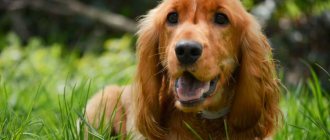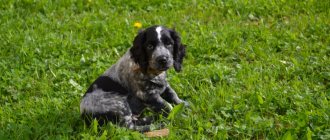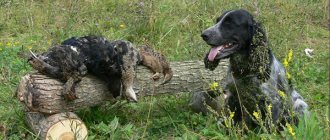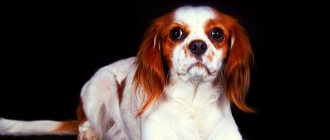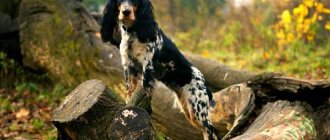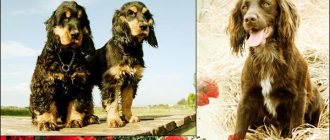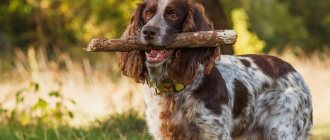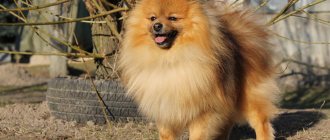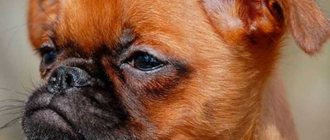The Russian spaniel is a hunting dog, a real pride of domestic dog breeders. This is the only domestic breed of gun dogs that is not recognized by the International Canine Federation, but is popular among hunters in our country and abroad. ROS (Russian Hunting Spaniel) is a special dog. It harmoniously combines: endurance, excellent working qualities, excellent physical characteristics, a gentle, kind disposition, playfulness and sociability.
Representatives of this breed help hunt feathered game and hares, serve in the police, and quickly and without errors find contraband and prohibited substances (drugs, explosives). Dogs are good for more than just work. Smart and loyal dogs make excellent companions with whom you can travel and spend active time.
We tried to collect in this material everything about Russian Spaniels (ROS), answer basic questions about the breed, and tell the main information that will be useful to the current and future owners of these dogs.
Story
The history of this young domestic breed of hunting dogs dates back to the end of the 19th century. Then the first representatives of the English Cocker Spaniel breed were brought into the country. In Russian conditions, these hunters did not receive the proper calling due to their short stature. In the conditions of Russian oak forests, stocky, short dogs experienced serious difficulties while hunting game birds.
At the beginning of the 20th century, lovers of hunting spaniels began to select for selection long-legged, tall dogs with a pronounced temperament. Such specimens were most suitable for bird hunting in domestic natural conditions. As a result of this work of breeders, by the 30s of the 20th century, a significant population of dogs had formed in the country, which were unlike any species of spaniel that existed at that time.
Purposeful work to develop and consolidate the new breed “Russian Spaniel” in the Soviet Union continued after the end of the Great Patriotic War. The goal of this difficult work was to breed a long-legged, friendly hunting dog. Specimens that were saved during the war were used for breeding, as well as different types of spaniels imported from abroad. The result of painstaking hard work was the first breed Standard, presented to the canine community in 1951. The Russian spaniel differed from the usual short cocker spaniel in size.
Work to improve the exterior and performance characteristics of the new breed was continued; for this purpose, representatives with the best field qualities were selected. The breed standard was supplemented in 1955 and 1966. Since 1972, only representatives of ROS were allowed to crossbreed; mating of these dogs with other spaniel breeds was prohibited.
Very kind breed
Advantages: Super breed.
Review: As a child, my friend had a cocker spaniel dog, only fawn in color. A super girl, an eternal wolf, loved to swim in the river, kind, affectionate, obedient, and quickly amenable to training. If there was an opportunity, I would definitely consider purchasing this breed of dog, the only thing with a spaniel is that you need to exercise every day, they are restless.
Article on the topic: Reviews from Chevrolet Cobalt 2014 owners
Description of the breed Russian Hunting Spaniel
A harmoniously built hunting dog with strong bones below average height - this description of the Russian Spaniel breed resembles the description of the related breed “English Cocker Spaniel”. Representatives of both species are similar, but professional hunters will never confuse these two dogs.
For those who are just getting acquainted with ROS, we have highlighted the characteristic features of the Russian Spaniel breed, by which you can easily distinguish them from Cocker Spaniels.
Similarities and differences in the description of a cocker spaniel and a Russian spaniel
The breed standards of these two varieties of dogs contain a small number of fundamental differences by which they can be distinguished from each other. These two hunters have quite a lot of similarities. Therefore, let us dwell in detail on the distinctive features:
- Representatives of the ROS breed have a longer body and legs. Cockers are more compact and shorter.
- Cocker Spaniels' ears should be set low (at eye level). In ROS, the ears are set moderately low.
- The Russian Spaniel's head is lighter than that of the AKC.
- Cockers have longer hair.
- Russians are less “shaggy”.
- The “English” have a wider muzzle and a more developed occipital protuberance.
Important: the Russian hunting spaniel and the English cocker spaniel are two independent breeds, and not different branches of one.
Related article:
Small dog breeds - top 35 breeds with photos and brief descriptions. It may also be interesting to read a list of the smallest dog breeds with photographs and a brief description of their characteristics.
How to choose a healthy puppy
When choosing a spaniel puppy, the first thing to do is pay attention to its appearance. The baby should be moderately well-fed, clean, and active. A healthy puppy has shiny, silky fur, clear, clean, not sour eyes, and a moist nose.
It is better to take a puppy from a kennel or from a trusted breeder, so that instead of an Irish water spaniel, a poodle is not slipped in.
Additional Information . The main difference between a water spaniel and a poodle is its hairless, rat-like tail.
Choosing a puppy
When purchasing a Cocker Spaniel puppy, you must remember that this is not a toy, but a good friend and companion for whom those who purchased it are responsible. Now the future fate of the pet, its physical health, emotional state, and life expectancy depends on the owner.
Breed standard Russian hunting spaniel
The official breed standard ROS is adopted only at the national level in Russia. Today, the edition approved by the decision of the Presidium of SOKO RKF (Union of Public Cynological Organizations - Russian Cynological Federation) dated January 29, 2020 is used. Until 2022, the edition of the Russian Spaniel Breed Standard dated April 19, 2012 was in effect.
ROS was introduced to the foreign community in the 90s of the last century. The International Cynological Federation still does not recognize the young Russian breed; in FCI documents it is classified as “outside the FCI classification”.
Outside the Russian Federation, the breed is recognized by only a few clubs and organizations:
- APRI = American Pet Registry, Inc.;
- CKC = Continental Kennel Club;
- DRA = Dog Registry of America, Inc.;
- FIC = Federation of International Cynologists;
- NAKC = North American Kennel Club;
- RSC = Russian Spaniel Club;
- UFC = Universal Kennel Club International.
According to the RKF breed standard:
- Body type. Strong, moderately squat. Dry type of construction.
- Rib cage. Long, moderate width and depth. The shape is oval. False ribs are developed.
- Back. Strong, straight. With well developed muscles.
- Limbs. Muscular. Direct. Parallel. The angle between the shoulders and shoulder blades is almost 100°. The angles of the hock joints are well defined. Elbows point straight back.
- Paws. The shape is round. Arched. The fingers are tightly clenched. The color of claws and pads is not established by the standard. There is thick fur between the toes.
- Gait. With free movements. Running - easy gallop.
- Neck. The length of the neck is commensurate with the length of the head. The position is average. The transition to the shoulders is smooth. The muscles are well developed.
- Head. Length – moderate. Dry.
- Muzzle. Wide. Tapers towards the nose. Equal to the length of the cranial part of the head.
- Nose. Wide. Nostrils are open. Nose - black and brown colors are allowed.
- Bite. Scissor-shaped. The teeth are strong, well developed, and fit tightly together. White color.
- Ears. Wide. Landing is above eye level. Long, hanging, mobile. Should fit snugly to the cheekbones. The bottom shape is round. Covered with silky wavy fur.
- Eyes. The shape is oval. Color ranges from light brown to dark brown.
- Tail. Mobile, well covered with hair. Harmoniously continues the top line. Thick at the base. Tapers towards the tip. According to the breed standard, docking of ½ length is allowed.
- Coat. The outer hair is of moderate length. Can be straight or wavy.
- Color of the Russian hunting spaniel. The new standard distinguishes two varieties: piebald and spotted colors and solid colors. The first type can be with or without specks (sparse or dense). In the second type, minor white markings are allowed on the dog’s throat, chest and paws. More information about colors in the subsection “Photos of colors”.
- Height at the withers of a Russian spaniel. In the new edition: height of males – 40-45 cm; females – 38-43 cm.
- How much does a Russian hunting spaniel weigh? The breed standard does not specify weight. The average weight of ROS is from 13 to 16 kg.
- How long does a Russian hunting spaniel live? Average life expectancy is 14 -15 years. They can live up to 20 years.
Description
The dog's body is approximately square in shape, the shape of the muzzle resembles a rectangle. The skull has smooth outlines, looks moderately light and moderately heavy. The nose is quite wide. Eyes are dark in color: brown in different shades. They are large, but without bulge. The expression in the eyes is good-natured and intelligent. There is a cheerful sparkle in the eyes. The ears are set at eye level, hang down and have a patchy shape. Thin ears are completely covered with silky hair. Neck without dewlap, medium length. Beautifully placed on the shoulders. The chest is strongly developed, but not wide. The shoulders are set obliquely and seem to merge with the body. The forelimbs are powerful and short, which provides the dog with strong support, but does not reduce its performance. Paws are covered with hair. The body is very strong for a small dog. The ribs are convex, the loin is short and strong. The topline is level and strong, sloping only slightly towards the croup. The croup is wide, round and muscular. The bones of the hind legs are strong, the knee joints have a good range of flexion, which ensures fast movement. Paws with soft cat pads. The tail is very mobile, set slightly below the level of the back. When moving, it is at the level of the back and never rides up. Docked mainly for hunting purposes, not too short.
Characteristics of the Russian Hunting Spaniel breed
These dogs were originally bred for hunting, so the main traits inherent in ROS are: endurance, excellent sense of smell, tirelessness, and perseverance. The character inherent in nature of the Russian hunting spaniel is best revealed during the hunt. There they patiently track down game, decisively rush into the water and jump into the swamp slush for prey, and boldly make their way through thickets of nettles and burdocks. Nothing can stop the hunting dogs.
A magical transformation happens to Russian spaniels when they return from hunting. At home, these tireless active and fearless hunters become ordinary sofa dogs. They behave good-naturedly and gently with their household members, and welcome guests. Ready to be close to the owner, no matter what he does. This may be surprising, but this is how most owners of dogs of this breed speak about their pets.
Dogs are non-conflict, non-aggressive, absolutely good-natured and generous towards children. They tolerate small children's pranks and become loyal friends for little family members. Get along with other dogs and cats. Caution should be exercised only by families with small pets: hamsters, rats, guinea pigs. The hunter's instinct can take over the dog, this can lead to dire consequences.
Adult dogs retain puppy playfulness and do not lose interest in various types of entertainment. The most favorite pastimes of this active dog are searching for any objects and fetching balls. Dogs need to be played with daily to avoid unwanted destructive behavior. Animals can compensate for the lack of play with chewed shoes.
Peculiarities
Representatives of the breed are distinguished by their gentleness, sensitivity, good nature and responsiveness. They have an open, kind character, they are attached to their beloved owner, they always frolic and are always happy. They try to instantly make friends with new pets or family members, sharing a piece of their good (by default) mood. They yearn for their owner in his absence, do not tolerate separation well, and if you decide to go on a long vacation, be sure to take your pet with you.
The spaniel is never aggressive, has a harmonious and balanced character: it will not cause a quarrel between dogs in the park and will not hurt a cat. The dog urgently needs physical exercise and activity, loves to play and frolic with children. If for some reason he does not receive due attention, his character deteriorates, as does his appearance. The dog gains excess weight, becomes capricious, and can destroy everything around while no one is home. In the modern world, it is no longer used for hunting, only as a companion, family dog, nanny and good friend.
The cocker spaniel makes a useless watchman and guard; he is very good-natured and completely unable to recognize the villain. On the contrary, he will run up to any stranger, wagging his tail and begging for goodies. The animal has no internal concept that a person can cause harm and be dangerous - he perceives everyone equally - as good friends. The cocker spaniel does not have a genetic code, like, for example, the German or Caucasian shepherd - it is not a guard, not a watchman. A characteristic feature of their character is independence; when executing a command, the dog itself will decide whether to obey or not.
Care and maintenance of the Russian Spaniel breed
The ideal place to keep ROS is a country house in the countryside with a spacious yard and a forest nearby. This is a real paradise for a hunting dog, who could realize his scouting instincts there, enjoy a variety of aromas, and unity with nature.
But in this dog paradise there is no place for a rotten kennel, an iron chain and a cramped enclosure. Spaniels can rest in the yard in warm, dry weather; in the summer they will not refuse to spend the night under a canopy. But they are not suitable for year-round outdoor use. A spaniel's place is in the house, next to its beloved owner.
A Russian Spaniel hunting dog can also be kept in city apartments. The main condition for such urban housing is sufficient walking, regular taking of the animal to nature and hunting. If you have a dog that is not trained to hunt, he also needs to be taken out of town for walks. You can take your pets with you on hiking trips through the forest. The compact dog fits perfectly into a regular backpack.
Important : if you compare how long Russian hunting spaniels live and companion dogs that do not take part in hunting, we can conclude that hunting has a positive effect on life expectancy.
Related article:
Nickname for a spaniel boy or girl - examples of names, tips, hunting nicknames . Not only does the puppy need to be selected according to many parameters, but it also needs to be named correctly. Read in a separate article about naming options for a spaniel puppy.
Muzzle for English Cocker Spaniel
This is one of the important components of a dog’s equipment for a walk, while traveling on public transport and when visiting a veterinarian. In order not to cause harm, the muzzle must be made of high-quality materials. The English spaniel is a relatively small and non-aggressive dog, so you can choose a leather or fabric product. It is important to choose the right size so that there is no discomfort, and at the same time the dog cannot lose it. You can choose the appropriate option from the following models offered on the modern market:
- leather;
- fabric;
- plastic.
How to care for a Russian Spaniel
The dog's luxurious coat requires regular and thorough care. She is combed 1-2 times a week. First, use a natural wide-tooth comb to comb out debris, then use a brush or fine-toothed comb to add shine to the coat. Brushing the fur not only removes dirt, dandruff, and dust, but also stimulates blood flow to the skin surfaces. Puppies need to be taught this mandatory procedure from a very early age, so that later they do not avoid it and calmly allow themselves to be brushed.
But bathing dogs completely with detergents and hygiene products is allowed 2-3 times a year. There is no need to carry out this procedure more often for preventive purposes. Extraordinary bathing is allowed only if necessary, if the animal has smeared itself in something. But even in such cases, it is better to wash the dog partially, without completely immersing it in water. Too frequent bathing washes away the protective oil layer from the coat.
Dogs of this breed get two types of haircuts:
- Hygienic. Held once every two weeks. The hair is trimmed around the fingers, in the vicinity of the pads, around the anus, near the auditory openings. The mats in the groin area are trimmed.
- Full. Professional haircut. It is carried out at intervals of 2-3 months in grooming salons.
The claws of spaniels that constantly walk on hard ground can wear down on their own. The owner must control the length of the claws, preventing excessive growth. Too long claws can dig into the animal's finger pad - this causes pain and discomfort to the pet.
It can also cause your dog to become lame. The claws are trimmed with a special nail clipper. The guillotine design is best suited for this. Trimming with simple scissors is unacceptable - this can lead to separation of the claws. It is allowed to use a file for this manipulation.
Your pet's large floppy ears require special attention. This signature POC needs daily inspection. During the inspection, contamination and traces of possible infections are revealed. The auricle is cleaned from the inside of dirt and wax with a damp swab or cotton pad soaked in warm boiling water. Do this as needed or 1-2 times a month.
Some publications recommend airing floppy ears. The advice is controversial, but not without meaning. This design of the ears, due to poor ventilation, creates an ideal environment for the growth and development of various microorganisms and mites. To ventilate your pet’s ears, you can wave them a little, like the wings of a butterfly, or secure the ears with a soft elastic band or a special clip above the dog’s head.
Caring for a Russian Spaniel puppy and an adult animal includes eye examination and cleaning. A healthy animal's eyes should be clean, without signs of souring or tear tracks. If something similar is detected in a dog, it should be shown to a veterinarian. For prevention, it is enough to wash your eyes with a cotton pad soaked in a decoction of chamomile or a weak tea solution.
Strong and healthy teeth are the pride of a hunting dog and a guarantee of his health. From puppyhood, dogs are taught to brush their teeth - this prevents the formation of tartar and gets rid of plaque on the teeth. Cleaning is carried out with a special toothbrush using toothpaste from a pet store. It is necessary to give preference to products without a strong smell and taste. At the end of cleaning, wipe the teeth with a soft cloth or dry cotton swab.
Important: it is necessary to ensure that the dog does not swallow the toothpaste - this can cause gastrointestinal upset.
How to train a pet?
Animal training should begin from an early age. Even as a puppy, he must understand who his owner is and what rules are established for him. But the owner will have to be patient: these kids are very playful and do not always immediately understand that behavioral boundaries have already been established for them.
Let’s say it will take several months to train an animal to go to the toilet in the right place. While the puppy is still very small, you don’t need to take him outside right away, just install a litter tray. Then, when the dog gets a little older, you can take it out as soon as it becomes noticeable that he is looking for a place where he can go to the toilet. Another point in this process is that the animal should not walk on stairs, otherwise it can easily damage the paw joints. Therefore, the emphasis is placed on the fact that it needs to be carried out by hand.
You should also remember that this animal is very cunning. When he sees that the owners are sitting down at the table, his appearance changes from cheerful and cheerful to dull and sad. With his mournful look, he begs for a piece of food for himself, and many owners begin to feed the dog with handouts from the table. This is the first mistake. The puppy must understand that he cannot beg.
Today there are many groups for animals of this breed. Almost all specialized publications contain photographs showing how a Russian Cocker Spaniel undergoes basic training courses. These are very good and useful lessons for them.
Health of the Russian Spaniel dog breed
The breed itself is considered quite healthy. With proper maintenance, proper care, adherence to the schedule of vaccinations and antiparasitic treatment, and a nutritious balanced diet, health problems rarely arise.
Genetic pathologies:
- cryptorchidism;
- hip dysplasia.
Other diseases to which the breed is prone:
- obesity;
- otitis;
- food allergy.
Feeding an adult dog and a puppy
Breed online: “spaniel from the Dynamo society”
Despite the anatomical features of the spaniel structure changing with age, the dogs are fed the same throughout their lives. The dog's diet should include:
- raw meat (horse, beef, lamb or chicken) and offal;
- deboned boiled fish;
- fresh grated vegetables, herbs and fruits;
- milk porridge made from rice, oatmeal or buckwheat.
If necessary, all of the above can be replaced with specialized dry food. Your veterinarian will help you choose the right brand. He will also advise the owner on the portion size required for a particular animal.
This is especially important for spaniels prone to overeating.
It is worth noting that even though the “menu” is completely identical, the feeding schedule for adult dogs and puppies is different. Children are offered food often, but in small portions. Gradually, the number of daily meals is reduced to 1 time per day. It is even beneficial for adult dogs to have periodic “fasting days.” This has a beneficial effect on their health.
Training dogs of the Russian hunting spaniel breed
We have already written that this breed is smart and easy to train. Puppy training begins from the first day of life in a new home. The owner must immediately show the new pet who is boss in the house. The training program is built depending on whether the dog will be used for hunting or will be a companion animal.
Training for hunting
Spaniels are hunting dogs with well-developed hunting instincts. During the hunt, they must go ahead of the hunter, find and flush out the game. They work without a stand, so the dog owner is in for a surprise effect. The second job function is to bring and serve the hunted prey to the hunter. Properly trained dogs do this without prodding from humans, they are excellent swimmers, and are not afraid to jump into ponds and swamps after birds.
Pets begin to be trained for hunting from an early age. The main command that working dogs are taught is: “Give it!” Active puppies are happy to bring and give to the owner a ball, a stick, or a bird's wing. The commands required for a hunting dog are: “Come to me!”, “You can’t!”, “Place!”, “Take it!” It is best to conduct training with a canine specialist. Energetic pets quickly remember commands, carry them out with enthusiasm, easily and naturally.
Raising pets
The main thing that needs to be taught to a companion dog is obedience. Hunting dog breeds, such as spaniels, may run away during a walk due to a sudden surge of hunting instinct. It is not uncommon for pets to get lost because of this. Another important and necessary command that should be one of the first to learn is “Fu!” or “You can’t!” This breed is a glutton that strives to pick up something on the street and eat it.
Breeding
The puppy must be selected at the age of 13 - 18 weeks, when it is already separated from its mother. It is important to choose an active, healthy-looking baby, his behavior and communication with other dogs. It is recommended to get acquainted with the baby’s parents, pedigree, documentation and veterinary passport. It is necessary to consult with breeders about the dog's nutrition. You should not take adult animals: the spaniel may be too attached to its previous owners and react aggressively to strangers who take it away from its familiar environment.
What to feed
The owner chooses the type of food (natural, industrial) for his pet. Both varieties are suitable; each owner decides what is more acceptable and convenient for him. The main thing is to monitor the volume of daily portions and avoid overeating.
Industrial feed
The daily ration is calculated using the formula: 40 g. feed for 1 kg. live weight.
Recommended brands of food:
- Acana Adult Dog Heritag;
- Orijen Adult Dog;
- Bosch Light;
- Brit Care;
- Royal Canin Adult Cocker.
Natural nutrition
Daily norm: from 30 to 60 g. per kilogram of animal weight.
A dog's diet should include:
- lean meat;
- beef tripe;
- lean sea fish fillet;
- quail egg;
- vegetables, greens;
- dairy products;
- bran;
- Brewer's yeast;
- porridge (oatmeal, buckwheat, rice).
Important: game caught during hunting is not included in the diet, so that the dog does not want to spoil the prey.
Nutrition
A small puppy must be fed the same food that he ate in the kennel. New products must be introduced gradually, 1 tablespoon at a time - this is important to avoid allergies. The food can be natural, it must contain the following ingredients:
- sea fish;
- vegetables and fruits (carrots, zucchini, bananas);
- fermented milk: kefir, fermented baked milk, cottage cheese;
- offal: lungs and liver;
- porridge: oatmeal, buckwheat, rice;
- meat in whole pieces: beef, turkey, boiled chicken.
You can feed dry food, premium and super premium. You cannot treat your pet to food from the table, fatty and fried, salted, smoked. Sweets are strictly prohibited.
Pros and cons of the Russian Spaniel breed
The characteristics of any breed have pros and cons; the Russian spaniel also has disadvantages and advantages.
Pros of ROS:
- Excellent hunting characteristics.
- Friendly disposition, lack of aggression.
- Devotion.
- Fearlessness.
- Suitable for keeping in a city apartment.
- The fur does not have the characteristic dog smell.
- Perky disposition, playfulness.
- Ability to get along with children and pets.
Cons of ROS:
- They shed heavily.
- They may overeat.
- Requires long active walking.
- Tendency to food allergies.
Education and training
For this breed, the main need is training, and constant training, since dogs forget commands over time if they are not constantly trained.
- In addition, you don’t even have to take your pet to a dog trainer, but simply teach him yourself, since this breed is very trainable.
- You can reinforce the result with the help of treats, because not a single cocker will refuse a tasty treat.
- As soon as you have an American Cocker Spaniel puppy in your home, you need to teach him two basic commands: “Sit!” and “You can’t!”
- And also make sure that the pet immediately knows its name and your hands, so as not to create unnecessary stress for it.
- Do not hit cockers under any circumstances. They have a very delicate mental organization, so they can be very offended by you and even become depressed.
Helpful parenting tip: Don't let your dog feel more important than you, especially if it's an American Cocker Spaniel. They can be very zealous.
Photos of colors of the Russian Hunting Spaniel breed
The breed standard specifies two types: solid, piebald and spotted. Minor white markings on the dog’s paws, chest and throat are allowed in solid colors (red spaniel, brown spaniel, black spaniel), and in the second type of color there may be specks of varying intensity.
- Black Russian Spaniel
- Brown and tan
- Black and tan
- Black and white Russian spaniel
- Red and white
- Brown-white
- Black and white with tan
- Brown-white and tan
Character
Good-natured, playful, and naturally lively, Cocker Spaniels are overly sociable and loyal.
The most important thing for them is to be closer to their owner. Qualities such as responsiveness and friendliness make pets ideal companions for a child of any age.
An English Cocker Spaniel and children will definitely become friends. Lonely elderly people will be pleased with their new friend. But no matter how many representatives the family consists of, the dog is truly attached to only one person.
Cocker spaniels can be stubborn. One can also observe a clear manifestation of a sense of ownership, especially when it comes to toys and other animal objects. An invariable favorite activity that spaniels do especially well is hunting. Their tirelessness and hard work in this field are off the charts. They have long been used by hunters to find and deliver shot animals.
Spaniels behave freely and easily with all household members, but strangers make them wary. Pets begin to bark loudly and decisively at strangers.
Spaniels are capable of jealousy, but they are not able to show feelings of resentment at all. If the dog is punished, then not even half an hour will pass before the furry friend will not remember the incident.
Spaniels can boast an enviable appetite. They have such a quality as indiscriminate eating, which is fraught with certain consequences. Therefore, owners need to carefully monitor their pet’s diet. This will not be easy to do, since dogs are prone to begging and will use all their charm.
Where to buy a puppy
When choosing a puppy, give preference to club pets so as not to purchase a mixed breed or a defective animal. Carefully study all documents: pedigree, field diplomas of parents, results of genetic tests.
Kennels of the Russian hunting spaniel:
- Shchelkovo ROSy, Moscow – russianspaniel.ru;
- Russian spaniels of St. Petersburg, St. Petersburg – russianspaniel-spb.com;
- Spaniels of the Volga region, Kazan – spaniel-volga.ru.
Owner reviews
Below we have given a couple of reviews from owners of the Russian Spaniel dog breed, which we received in personal messages. If you found these reviews useful, write your review in the special feedback field below and share your experience. After all, a live review from a spaniel owner is very valuable for people considering purchasing a puppy of this breed, who would like to learn more about the wonderful Russian Spaniel dog breed.
Nikolay: “When I was going to get a dog, I had a choice of two breeds: Russian black spaniel and cocker. I doubted that I needed a dog for hunting and fishing. Having studied almost everything about Russian spaniels on the Internet, I gave preference to the ROS puppy. And I was not mistaken. This is an unusual dog. She is at the same time calm at home, active and inquisitive in the forest. It is important to let her express this activity to the fullest. The spaniel is cramped in the courtyard of a multi-storey building; he needs a lot of free space.”
Svetlana: “My brother the hunter has a black spaniel. This is a tireless dog, an energizer battery. Curious, inquisitive, a real explorer! One can envy her energy. The children adore her, she answers them in kind. It’s always fun and interesting with her.”
Best friend
Advantages: Omnivorous, playful, easy to care for. perfectly trainable.
Disadvantages: Constantly watch the eyes and ears, these are the dog’s weak points!
Review: Six years ago I was given a small lump that fit in the palm of my hand. I still admire this breed! I have a black male, his name is HUNT, which means agile hunter. And he really lives up to his nickname. A restless little boy who sensitively senses your mood. But he needs to be brought up strictly, they are very cunning. You won't have time to blink an eye. sits on his head and dangles his paws! A great friend for a child! A very active dog, loves to swim. what's in the bath. what's in the pond. Mine is so… Read more
